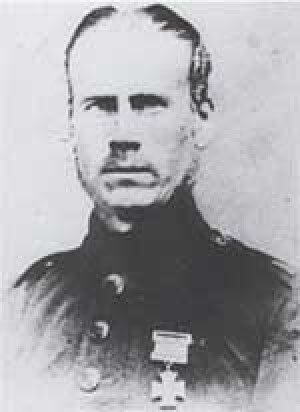1ST BATTALION, THE RIFLE BRIGADE
The Only VC won on Canadian Soil
Ten years after Queen Victoria instituted the Victoria Cross, a 20-year old Irish soldier won the Empire’s highest award far from the scene of any combat, at Danville, Quebec, Canada. Private Timothy O’Hea was honoured “for conspicuous courage under circumstances of great danger” – an almost classic understatement.
On the afternoon of 9th June 1866, a railway train from Quebec stopped at Danville. Locked in converted boxcars were 800 German immigrants. In another boxcar was 2000 pounds of ammunition for use against the Fenian raiders and it was Timothy O’Hea’s job along with four other men of the 1st Battalion Rifle Brigade to guard.

Late in the afternoon, O’Hea noticed that the boxcar containing the ammunition was on fire and after shouting an alarm, discovered the railwaymen and other soldiers had fled. O’Hea grabbed the keys to the boxcar from a dithering Sergeant and climbed aboard. He ripped burning covers off ammunition cases and tossed them outside, then for almost an hour, making 19 trips to a creek for buckets of water, he fought the flames, the immigrants cheering him on unaware of their peril.
Timothy O’Hea fought on alone and won. By evening, the ammunition had been loaded into another car and the train – immigrant coaches still attached – was on its way again. O’Hea not only displayed great courage and total disregard for his own life in putting out the fire in the boxcar, but also saved 800 immigrants from certain death had the ammunition exploded. His was the only Victoria Cross ever won in Canada.
The name of Private Timothy O’Hea VC is inscribed on the Rifle Brigade’s roll of honour in Winchester Cathedral, England and his medal resides in the Royal Green Jackets Museum, also in Winchester. O’Hea eventually died in Australia in 1874 and is buried in Sturt’s Desert, Queensland.At the time of his death, O’Hea’s VC was nowhere to be found. The mystery of its whereabouts was solved in 1950, when the medal turned up, after 76 years, lying in a drawer in the Art Gallery of new South Wales. Apparently, O’Hea had left it with a friend who had “presented it to the gallery.”
Julian Gatt
There seems to be some conjecture as to who died where. A book by Elizabeth Reid suggests Tim died in Ireland and that it was his brother who is buried in the Australian desert. Do you have any information that would quash this theory please?
I am a researcher of Victoria Cross recipients and their burial places.
Thankyou
Anthony Staunton
Elizabeth Reid suggested a possibility in her book published in 2005. However, no evidence was ever published and sadly, she died before the production of the documentary in which she would have included her evidence.
I recently updated the Wikpaedia O’Hea article to correct the location of where O’Hea died. It was the Sturt Stony Desert in the far south western border area of Queensland. The Tirari Desert, hundreds of kiliometers away in South Australia is still mentioned in the Find a Grave article.